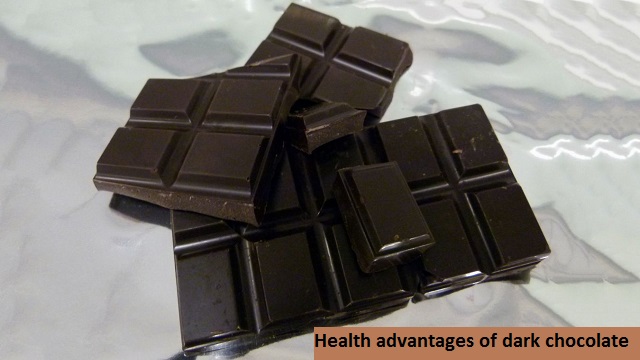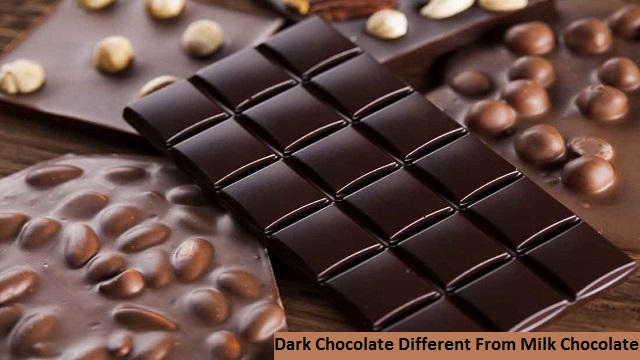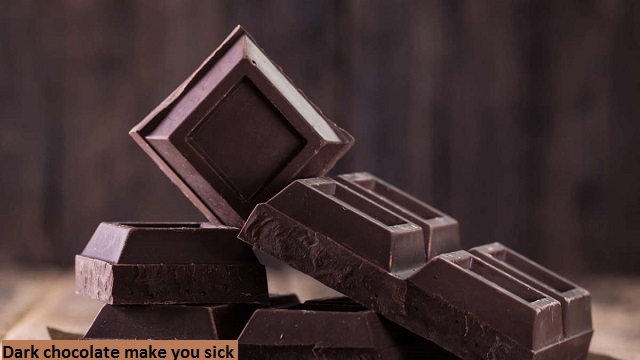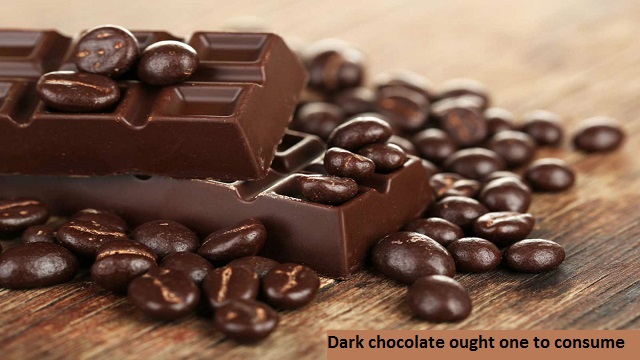
You’ve been missing out on these health advantages of dark chocolate.
When you decide to treat yourself in the future, choose some dark chocolate. The health advantages of dark chocolate far outweigh those of other candies and chocolates, despite the fact that it isn’t always the preferred choice due to its bitter taste.
Dark chocolate is more than just a decadent treat; it has long been studied for its health advantages and consumed for its alleged therapeutic properties. We’ll explain why dark chocolate has so many health advantages, as well as how much and how frequently you should eat it.
Let’s face it, one of life’s most decadent treats is chocolate. Whatever way you choose to consume it—as a candy bar, in a hot beverage, or drizzled over ice cream—chocolate is a happy food.
Despite the fact that chocolate is a delectable food, it isn’t always healthy or even chocolate. For instance, white chocolate is free of cocoa solids. That implies that it is much more of a confection than anything else.
IMPORTANT NOTE:The amount of dark chocolate you consume still matters, and if you consume too much, the extra fat, sugar, and calories may outweigh the health benefits. Keep this in mind before you go out and start chowing down on dark chocolate bars every day.
Will dark chocolate make you sick?
Dark chocolate is superior to other types of chocolate. Peart notes that dark chocolate has more of the healthy antioxidants known as flavonoids than milk or white chocolate while also having less added sugar and fat.
Ingredients like cocoa butter, sugar, and cocoa solids are the same in both milk chocolate and dark chocolate at their core. But the proportion of cocoa solids in the two types of chocolate varies.
According to Peart, dark chocolate contains 50% to 90% cocoa solids. And between 10% and 50% is found in milk chocolate. “.
Unsurprisingly, the extent of the health benefits of dark chocolate can vary depending on the amount of cocoa solids. According to Peart, products with a higher percentage of cocoa solids have more flavonoids and less sugar. There won’t be as much additional sugar if you use 75 or 80 percent dark chocolate as opposed to 50 percent. “.
Here are a few additional advantages of dark chocolate besides its lower sugar content:.
How Does Dark Chocolate Taste?
A bitter, healthy treat is dark chocolate. The liquor, a paste created from ground, roasted, shelled, and fermented cocoa beans (referred to as nibs), is then partially defatted to create cocoa powder. On the packaging of a chocolate bar, the term “percent cacao” refers to cocoa liquor.
The health benefits of chocolate will be greater the more bitter it is. Dark chocolate is particularly rich in flavonoids, particularly flavanols (flavan-3-ols), which are responsible for the bitter taste.
When compared to other types of chocolate, dark chocolate has the highest concentration of cocoa flavonols, also known as phenolic antioxidants. Antioxidant activity is primarily brought on by flavonoids like procyanidins, epicatechin, and catechin.

How Is Dark Chocolate Different From Milk Chocolate?
The cocoa liquor, cocoa butter, and sugar are all combined to create chocolate. Condensed milk or milk powder are mixed into the mixture to create milk chocolate.
Without additional milk solids, dark chocolate has a higher cocoa content. A chocolate bar must contain at least 12 percent milk to be referred to as milk chocolate.
Dark chocolate is frequently referred to as semisweet or bittersweet and must have a minimum of 35% cocoa liquor by weight. Only cocoa butter—at least 20% of the total weight—along with sweeteners and dairy products are used to make white chocolate.
The Health Benefits Of Dark Chocolate Throughout History.
Dark chocolate was used as a primary remedy or as a way to help deliver other medicines at the same time, and it has been documented that people began consuming foods and beverages made for the Theobroma cacao tree as early as 460 AD.
Indigenous peoples in Mesoamerica used chocolate, which later spread to Europe in the middle of the 1500s. There were well over 100 documented medical uses for cacao/chocolate between the 16th and 20th centuries.
These were the top three uses out of the 100:
- To help emaciated patients gain weight.
- To increase the nervous system’s activity.
- To enhance gastrointestinal and bowel movements.
Despite this, the majority of conclusive studies have been conducted in the past ten years, with a particular emphasis on the connection between cocoa consumption and cardiovascular risk. Insight into the potential health benefits of cocoa for other parts of the body, such as the organs and the mind, has recently come to light.
What Uses Does Dark Chocolate Have?
According to all available research, eating moderate amounts of chocolate or cocoa is probably healthier than not. Dark chocolate’s cocoa solids have been demonstrated to mediate cardiovascular effects, offer anti-inflammatory benefits, and possibly even have a direct impact on insulin resistance and the risk of developing diabetes.
Consuming cocoa may also alter redox-sensitive signaling pathways involved in immune response and gene expression, shielding nerves from inflammation and injury, shielding the skin from UV-induced oxidative damage, and having positive effects on satiety, brain function, and mood.
We’ve examined the science and deconstructed it so that you can fully comprehend the health advantages of eating dark chocolate.

Will dark chocolate make you sick?
Dark chocolate is superior to other types of chocolate. Peart asserts that chocolate has less added sugar and fat than milk or white chocolate while also pointing out that it is rich in flavonoids, which are powerful antioxidants.
The basic components of both milk chocolate and dark chocolate are cocoa butter, sugar, and cocoa solids. However, the percentage of cocoa solids in the two varieties of chocolate varies.
According to Peart, chocolate contains between 50 and 90 percent cocoa solids.
It should come as no surprise that the extent of the health benefits of chocolate can vary depending on the amount of cocoa solids. According to Peart, products with a higher percentage of cocoa solids contain more flavonoids and less sugar. “There will be less added sugar if you use 75 or 80 percent chocolate than if you use 50 percent dark chocolate. ”
Bounding in flavanols.
The cacao tree and other plants contain a type of flavonoid called flavanol. Cacao beans, which are used to make chocolate, are produced by these trees. According to Peart, cacao beans are a rich source of flavanols. “Cacao beans are fermented and then roasted to produce cocoa beans. From those, we create cocoa solids. “.
Dark chocolate has two to three times as much flavanol-rich cocoa solids as milk chocolate, according to Peart.”. “It is noticeably higher. “.
That has a significant positive impact on your heart’s health. Nitric oxide, which relaxes your blood vessels and enhances blood flow, is related to flavanol production. This consequently lowers blood pressure.
Our general health benefits greatly from improved blood flow. Peart claims that increased blood flow will shield one from heart disease. Due to increased blood flow to the brain, it is also beneficial for cognition (understanding thought). “.
Flavanols are advantageous in preventing cellular damage associated with aging because of their antioxidant properties.
Additionally, there is some evidence that chocolate with more flavanols may improve insulin sensitivity, though more studies are still needed to confirm this. According to Peart, your risk of developing diabetes decreases the more sensitive you are to insulin.
The Health Benefits of Dark Chocolate You’ve Been Missing.
1.Rich in Nutrients.
Consuming dark chocolate in moderation is best. While a 100-gram bar (3.15 ounces) has a lot more nutrients than the daily recommended amount to reap the health benefits of chocolate that brought you to this article, it can still pack a nutritional punch.
This is what a 101g bar of 70–85% cacao dark chocolate contains:
11 points for dietary fiber.
Omega-3 intake overall: 34 mg.
1230 mg of omega-6 total.
RDI of iron is 67%.
Magnesium: 58% of the RDI.
89 % RDI for copper.
RDI for manganese is 98 percent.
22 percent of the RDI is for zinc.
7.10.9g of protein.
2100 mg of sterols.
80 points eight milligrams of caffeine.
810 mg of theophylline.
2.High Levels of Antioxidants:
A significant number of organic compounds in chocolate are biologically active and serve as antioxidants. The study tested a variety of fruits, including acai berries and blueberries, and found that cocoa and chocolate may contain higher levels of antioxidants.
Polyphenols, flavanols, catechins, as well as a few other antioxidants, are responsible for the health advantages of chocolate.
3.Improved blood flow and lowered blood pressure.
It has been discovered that the flavanols in chocolate actually encourage the endothelium, the lining of the arteries, to produce nitric oxide (NO). Nitric oxide is responsible for relaxing the arteries, enhancing blood flow, and lowering blood pressure, which is why this is advantageous.
Despite the sparse evidence, it is advised to incorporate modest amounts of polyphenol-rich chocolate into a regular diet to effectively lower blood pressure and enhance the production of vasodilatory nitric oxide (NO).
4.Reduced Heart Disease Risk:
In the past 30 years, a significant amount of research has been done on the relationship and advantages of flavanols, cocoa chocolate consumption, and heart disease. Despite being observational studies, take a look at some of the results:.
Consuming cocoa decreased the risk of dying from heart disease by 50% over a 15-year period, according to one study involving 470 elderly male participants. According to another study, eating chocolate twice or more a week reduces the risk of developing calcified plaque in the arteries by 32%.
Additionally, consuming chocolate more than five times per week reduced the risk of heart disease by 57 percent, according to another study.
Given the nutrients in chocolate, it is most definitely plausible that regularly consuming small amounts of the chocolate throughout the week can help lower your risk of developing heart disease over the long term, even though it is difficult to say that chocolate was the only factor.
5.Prevention of UV deterioration:
It has been discovered, as was already mentioned, that cocoa’s high flavanol content can act as a photoprotectant against sun damage. Flavanols have been linked to improved blood circulation, reduced skin roughness, skin density, and dehydration, according to some studies.
In contrast to conventional chocolate, which has no such effect, regular consumption of chocolate rich in flavanols provided significant photoprotection from the damaging UV effects on the skin, according to a double-blind in vivo study conducted in 30 healthy subjects over a 12-week period.

How much dark chocolate ought one to consume?
Dark chocolate has much greater health advantages than milk chocolate, but it’s important to limit how much you eat at once to prevent the benefits from being cancelled out. In addition to reducing unnecessary sugar intake, dark chocolate helps you consume more stearic acid, a saturated fat that seems to have no effect on blood cholesterol.
We advise purchasing chocolate that is at least 60% cacao, keeping in mind that the higher the percentage, the more flavanols the batch will contain.
Additionally, we advise utilizing natural cocoa rather than Dutch-processed cocoa. The reason is that Dutch chocolate loses the health benefits of chocolate that the flavanols provide because it has been treated with an alkali, a substance that neutralizes acid and removes the strong bitter flavor.
Overall, we advise keeping chocolate intake to no more than 1 ounce per day, or a maximum of 3 times per week, for a total of 150 calories. You should always use moderation, right?
Finally, there are health advantages to dark chocolate.
You now have plenty of compelling reasons to choose chocolate over milk if you’re going to eat chocolate. In addition to having a higher antioxidant content than the majority of foods, cocoa benefits nitric oxide production, blood pressure, blood flow, and even helps reduce insulin resistance.
Small amounts of chocolate consumed on a regular basis over the long term can shield the skin from UV rays and lower the risk of illness.
While the research is still in its early stages, the Cleveland Clinic advises choosing a moderate serving of chocolate (about 1 ounce) a few times per week along with other foods high in flavonoids like apples, red wine, tea, onions, and cranberries.
Read More: The Science Of “Bonking
Leave a Reply